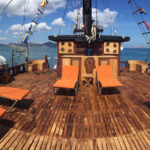Beginning next week and running for 11 weeks, The Scuba News Canada will feature a shipwreck story from every province of Canada, as well as one in Canada’s north. Although both the east and west coasts, along with the Great Lakes, are best known for shipwrecks, we will feature a shipwreck from even the landlocked provinces. Stay tuned for our first shipwreck story from Matt Lerpiniere’s adventure in Bell Island, Newfoundland.
A frequent cause of shipwrecks in earlier times was getting lost and running aground. But the failure of technology also accounts for some of history’s most infamous shipwrecks. The best example is the sinking on its maiden voyage of the SS Titanic, the greatest technological achievement of its day. It went to the bottom after hitting an iceberg on a foggy April night in 1912, 320 nautical miles (600 kilometres) off Newfoundland. More than 1,500 people died.
Shipwrecks fascinate many, including marine archaeologists. The popularity of scuba diving has sparked interest in wrecks. However, some archaeologists are concerned that divers may damage fragile shipwrecks. In this country the Canada Shipping Act governs marine salvage, including shipwrecks. The act is administered by the Canadian Coast Guard. Still, divers are discovering wrecks of historic value in Canadian waters.








